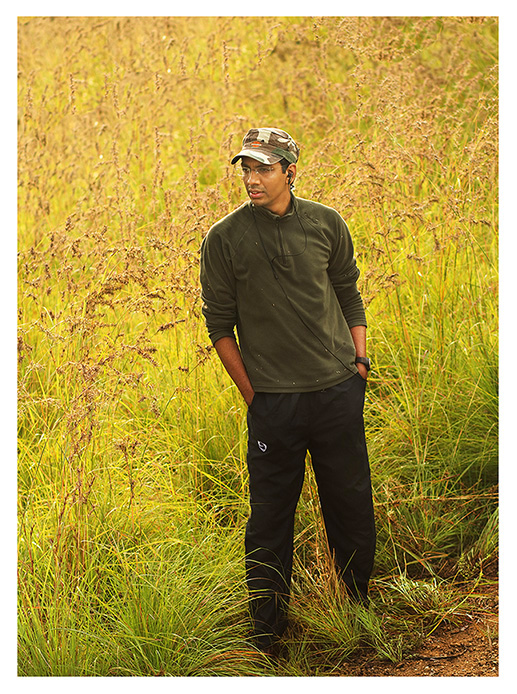When it comes to using flash – I generally bounce it off walls, ceilings and any other surface I can get hold of in the vicinity. Well I dont curse myself for that since I mostly shoot indoors with a flash. The light is beautifully directional but with the side-effect of acquiring the color cast of the surface it bounced off of. But what if I didnt have anything to bounce the light off; what if I shot exclusively outdoors…!
I use the Canon 580EXII. In the E-TTL II mode, it defaults to the fill-flash mode. While shooting, the camera first meters ambient light on half-press of the shutter button and then on full press, a low power pre-flash is fired from the flash gun. The reflected light is also metered by the same metering system as used for ambient. An algorithm then calculates the correct flash exposure after comparing the ambient and the flash exposure from – as per the white paper for the 1D MKII – the central 17 metering zones. Areas with large difference between ambient and pre-flash readings are excluded or given a lesser weightage as they are assumed to be a highly reflective object like mirror, glass panes etc.
Unlike E-TTL, E-TTL II can also use distance information provided by compatible lenses (most canon lenses do this). Also, E-TTL II is not completely focus point linked. So regardless of what metering method is selected for ambient metering, the camera uses either evaluative or average (based on selection) to meter the pre-flash exposure.
There are two algorithms that can be used – evaluative and average. The Evaluative takes into account the inputs from the entire frame for calculating the exposure, whereas the average gives more weight to the zones around the focus point. How the E-TTL II algorithm exactly works has not been revealed by canon. Its left to the user to try out these methods to know what best suits their taste.
I visited Cauvery fishing camp for a couple of days – a team outing. The weather was awesome. Gently overcast with the sun occasionally peeping out from behind the clouds. The light was great for portraiture, all day (barring the short but heavy spell of rain early one evening). This gave me a good overall exposure on the subject but the light still appeared a bit flat and boring for my taste. So I had to make my ‘models’ pose in a way and in locations where there was a gradient of light and then use the flash to fill in the shadows.
Heres the first one where I positioned Pradeep under this huge tree a couple of hops inside the river. The metering was for the background, which was giving me a pretty high exposure. But there was very little light under the tree. I didnt have a ND filter and so had to compromise a little with the background. I overexposed it by 2/3rd of a stop to get more leverage on the foreground subject.

In the shade
Used 580EXII with the white-card and tuned the exposure to -1 on E-TTL. The flash did a great job and I got a nice even exposure with the main light still being directional.
The rest were taken the next morning when the sun was beautifully directional. There was a thin cloud cover which diffused the light a little. This one is with Pradeep standing with the sun right behind his back. The 580EXII was on his left (camera right) with the white card on and with -2 comp. I climbed over the ladder of the watch tower behind to get this ariel view – specifically to get all the beautiful lemon grass background.

Lemon Grass
The next one is where I had Pradeep stand in the way leading down from the hill. He suggested if he can make it more dynamic with he posing as walking up the hill. This worked very well. The sun had come out from the clouds and was directly incident on him at a low angle from his left. The foreground path and grass too were well lit, but that made a strong shadow on the opposite side. This was filled in with the 580EXII from camera left and at -1 comp pointed straight at his face zoomed to 105mm.

Path
The last one is Satish standing in tall grass with the sun on him from his right. That meant shadows on his left. Again 580EXII from camera right at -3 comp and pointed directly at him zoomed to 105mm. It was a -3 because the light was more diffused. What it really did was to lift up the light under the eye-sockets and add catch light in his eyes. U can almost see the flash in his eyes.

One with Nature
Notice that this is an article about fill flash and the flash is NOT the only or dominant source of light. It works best when u apply the flash to a side of the subject’s face. If the flash is mounted on-camera, the subject could be asked to turn their heads so one side faces the camera more than the other. The other side ofcourse should be facing the dominant source of light – in this case – natural sun light. The E TTL II balances the flash with the ambient lighting, considering the dialed exposure compensation. Some experiment is needed to get comfortable with E TTL II.
Wonderful trip all in all. Two days arent enough when you are having so much fun…
Jain
Nice post Niraj .. Can u have a post regarding lighting for beginners?
Niraj
thnx.. Some of my previous posts have more on lighting and setups. Check out: https://nirajkedar.com/blog/2010/11/just-one-light/
Not detailed but should give you a fair idea. More will follow. Do keep visiting
Randhir
Excellent writeup there Niraj. Fantastic photographs. Keep up the good work as ever.
Niraj
thanx Randhir… i appreciate